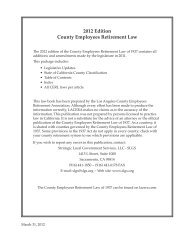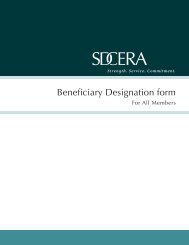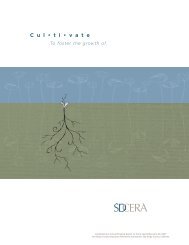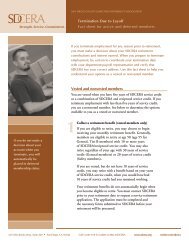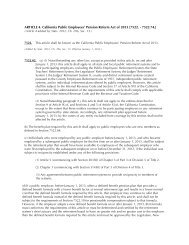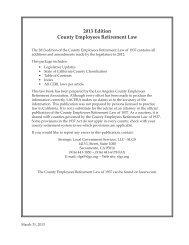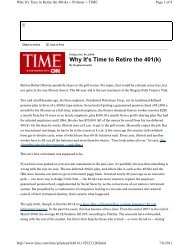Dividing Community Property booklet - sdcera
Dividing Community Property booklet - sdcera
Dividing Community Property booklet - sdcera
Create successful ePaper yourself
Turn your PDF publications into a flip-book with our unique Google optimized e-Paper software.
DIVIDING COMMUNITY<br />
PROPERTY<br />
How legal separation or divorce<br />
affects your SDCERA benefit
SAN DIEGO COUNTY EMPLOYEES<br />
RETIREMENT ASSOCIATION<br />
DIVIDING COMMUNITY PROPERTY INFORMATION BOOKLET<br />
Updated information<br />
DOMESTIC PARTNERSHIP<br />
Assembly Bill 205 extends the rights and duties of marriage to persons registered as<br />
domestic partners and provides the state’s superior courts jurisdiction in governing the<br />
dissolution and legal separation of domestic partnerships.<br />
Page 2<br />
JOINDER REQUIREMENT<br />
SDCERA will accept service of joinder by mail at the following address:<br />
San Diego County Employees Retirement Association<br />
2275 Rio Bonito Way, Suite 200<br />
San Diego, California, 92108-1685<br />
Page 3<br />
INFORMATION FOR ATTORNEYS DRAFTING DOMESTIC RELATIONS ORDERS<br />
The sample DROs enclosed in the pocket of this <strong>booklet</strong> may be revised periodically.<br />
Before preparing a draft, please contact the SDCERA Call Center at 619.515.6800 or tollfree<br />
at 1.888.473.2372 to request the most recent versions.<br />
Page 13 (last page)<br />
REQUEST FOR ESTIMATE/STATEMENT OF ACCOUNT DUE TO LEGAL SEPARATION<br />
OR MARITAL DISSOLUTION<br />
Complete the form and send it to SDCERA at the following address:<br />
San Diego County Employees Retirement Association<br />
2275 Rio Bonito Way, Suite 200<br />
San Diego, California, 92108-1685<br />
2275 Rio Bonito Way, Suite 200, San Diego, CA 92108-1685 • www.<strong>sdcera</strong>.org • PHONE 619.515.6800 • TOLL FREE 888.473.2372<br />
Rev. 5/08
DIVIDING COMMUNITY PROPERTY<br />
HOW LEGAL SEPARATION OR DIVORCE<br />
AFFECTS YOUR SDCERA BENEFIT<br />
This summary <strong>booklet</strong> provides disclosure of certain terms and conditions of SDCERA membership and benefits for the purpose of assisting<br />
members involved in the dissolution of marriage. It is designed to provide information as simply and accurately as possible as of the date of<br />
issuance of this <strong>booklet</strong>. SDCERA is governed by the County Employees Retirement Law of 1937 (Government Code Section 31450 et seq.) as<br />
it has been adopted and implemented by the San Diego County Board of Supervisors and the SDCERA Board of Retirement. If there is any<br />
inconsistency between this <strong>booklet</strong> and the governing law, the law will govern. Decisions relating to the plan will be made after reference to<br />
the statutes and any resolutions, regulations and policies governing administration of SDCERA, as they exist at the same time of the decisions.<br />
6/04<br />
}
CONTENTS<br />
Introduction . . . . . . . . . . . . . . . . . . . . . . . . . . . . . . . . . . . . . . . . . . . . . . . . . . . . . . . . . . . . 1<br />
Notifying SDCERA of pending legal separation or marital dissolution action . . . . . . . . . . . . 1<br />
Request for confidential member information . . . . . . . . . . . . . . . . . . . . . . . . . . . . . . . . . . . 2<br />
Actuarial valuation . . . . . . . . . . . . . . . . . . . . . . . . . . . . . . . . . . . . . . . . . . . . . . . . . . . . . . . 2<br />
Legal requirements and procedures . . . . . . . . . . . . . . . . . . . . . . . . . . . . . . . . . . . . . . . . . . . 2<br />
Joinder requirement . . . . . . . . . . . . . . . . . . . . . . . . . . . . . . . . . . . . . . . . . . . . . . . . . . . . 2<br />
Domestic relations order requirement . . . . . . . . . . . . . . . . . . . . . . . . . . . . . . . . . . . . . . 3<br />
Information for attorneys drafting domestic relations orders . . . . . . . . . . . . . . . . . . . . . . . . 3<br />
Methods of dividing community property . . . . . . . . . . . . . . . . . . . . . . . . . . . . . . . . . . . . . . 4<br />
Methods available to active and deferred members . . . . . . . . . . . . . . . . . . . . . . . . . . . . . 4<br />
Separate account . . . . . . . . . . . . . . . . . . . . . . . . . . . . . . . . . . . . . . . . . . . . . . . . . . . 4<br />
Shared payment . . . . . . . . . . . . . . . . . . . . . . . . . . . . . . . . . . . . . . . . . . . . . . . . . . . . 5<br />
Summary of methods available to active and deferred members . . . . . . . . . . . . . . . . 6<br />
Method available to retired members . . . . . . . . . . . . . . . . . . . . . . . . . . . . . . . . . . . . . . . 7<br />
Effects of dissolution on beneficiary designation . . . . . . . . . . . . . . . . . . . . . . . . . . . . . . . . . 7<br />
Frequently asked questions . . . . . . . . . . . . . . . . . . . . . . . . . . . . . . . . . . . . . . . . . . . . . . . . . 8<br />
Definitions . . . . . . . . . . . . . . . . . . . . . . . . . . . . . . . . . . . . . . . . . . . . . . . . . . . . . . . . . . . . 10<br />
Form: Request for Estimate/Statement of Account Due to Legal Separation or Marital Dissolution<br />
}
INTRODUCTION<br />
SDCERA retirement benefits are generally payable only to members or their beneficiaries and<br />
cannot be paid to others. California state law recognizes an exception to this rule in the case<br />
of legal separation and dissolution of marriage. Because retirement benefits earned during<br />
marriage are considered community property assets, they must be considered in the property<br />
settlement agreement and are subject to disposition by the court.<br />
This <strong>booklet</strong> provides information for members, nonmembers and their representatives to<br />
assist in the allocation of a member’s retirement benefit. All parties are encouraged to review<br />
the SDCERA Retirement Plan <strong>booklet</strong>, which describes the plan and various benefits available<br />
to the member.<br />
NOTIFYING SDCERA OF PENDING LEGAL<br />
SEPARATION OR MARITAL DISSOLUTION<br />
ACTION<br />
When a legal separation or marital dissolution action has been filed, the member and/or other<br />
parties involved should notify SDCERA immediately in writing. The nonmember has an<br />
interest in the member’s retirement account if he/she was married to an SDCERA member<br />
while the member worked for the County of San Diego*. To protect the nonmember’s interest<br />
in the plan, SDCERA should be notified in writing that the nonmember is asserting a claim for<br />
community property interest in the member’s benefit.<br />
Additionally, SDCERA requires that it be joined as a party to the dissolution proceeding<br />
pursuant to sections 2060-2065 of the California Family Code.<br />
Once notified, the case will be assigned to a manager, who will answer questions, provide<br />
necessary materials, receive and review the domestic relations order and other documents,<br />
and notify the appropriate parties throughout the process.<br />
When SDCERA first receives notice of a pending dissolution, legal separation or is served with<br />
a joinder, and the member has not retired, the pending dissolution is noted in the member’s<br />
account. SDCERA is unable to distribute any payments from the member’s account until the<br />
legal separation or dissolution is resolved and SDCERA has been notified by joinder.<br />
If the joinder is withdrawn, written notice is required. The joinder of SDCERA can be released<br />
only with a court-approved Petition to Dismiss or, in the case of reconciliation, a copy of the<br />
court order that dismisses the legal separation or dissolution case.<br />
*County of San Diego may also include other participating employers.<br />
}<br />
1
REQUEST FOR CONFIDENTIAL MEMBER<br />
INFORMATION<br />
By law, a member’s retirement records are confidential. To release information about a<br />
member’s account, SDCERA must receive one of the following:<br />
or<br />
• Written request from the member (form enclosed) outlining the specific data needed:<br />
Marital period (date of marriage, date of separation)<br />
Member’s name and Social Security number<br />
Member’s current address<br />
Name and address of the attorney representing the member<br />
Former spouse’s name and date of birth<br />
Former spouse’s current address, or name and address of the attorney representing<br />
former spouse<br />
• Subpoena duces tecum, which may be served on SDCERA by mail<br />
ACTUARIAL VALUATION<br />
SDCERA does not provide actuarial valuations of a member’s retirement benefits, legal, tax or<br />
other advice concerning the division of a member’s benefits. An actuary may be retained by<br />
the parties to determine the present value of the benefit.<br />
LEGAL REQUIREMENTS AND PROCEDURES<br />
JOINDER REQUIREMENT<br />
Joinder is a legal process that names SDCERA as a third-party claimant in the legal separation<br />
or dissolution proceeding (section 2060-2065 of the California Family Code).<br />
When joined, SDCERA is notified of legal separation or dissolution of marriage action and is a<br />
party to that action. SDCERA requires that it be joined as a party to the proceeding and will<br />
not recognize court orders addressing a member’s account in the system unless SDCERA has<br />
been joined.<br />
Joinder forms are available from the court. The member or representing attorney must<br />
complete these forms, file them with the court and serve them on SDCERA. SDCERA will<br />
accept service of joinder by mail at the following address:<br />
San Diego County Employees Retirement Association<br />
401 West A Street, Suite 1300<br />
San Diego, California 92101-7906<br />
If both parties have pension plans and each party retains his/her pension plan in total, or if the<br />
SDCERA member will retain all interest in his/her plan due to a buyout of the former spouse’s<br />
community property interest, SDCERA does not need to be joined as a party to the<br />
}<br />
2
dissolution. In this case, the member should give SDCERA a copy of the order establishing<br />
that the pension is entirely his/her sole and separate property.<br />
DOMESTIC RELATIONS ORDER REQUIREMENT<br />
A domestic relations order (DRO) is a legal document. It consists of a stipulation signed by all<br />
parties and an order executed by a judge identifying how retirement benefits are to be<br />
divided.<br />
For a DRO dividing community property interest to be acceptable, it must be in compliance<br />
with the terms of the 1937 Act and other applicable laws. A court cannot make an order that<br />
is not in compliance with the 1937 Act or that would require the retirement plan to make<br />
payments in any manner that would result in an increase in the amount of benefits provided<br />
by the plan. Under no circumstances will payments be made to the member and nonmember<br />
that exceed the amount that otherwise would have been paid to the member alone. This may<br />
result in a reduction of the retirement benefit to both the member and the nonmember.<br />
To avoid unnecessary delay, a draft DRO should be submitted to SDCERA for pre-approval<br />
before obtaining the signatures of the member and nonmember. SDCERA will review the draft<br />
and may recommend changes, then will return the draft to the appropriate parties for signing<br />
and filing with the court.<br />
SDCERA should sign the final version of the DRO after both parties have signed but before<br />
filing with the court. Once the court approves the DRO, SDCERA requires a conformed or<br />
certified file-stamped, court-executed DRO.<br />
INFORMATION FOR ATTORNEYS DRAFTING<br />
DOMESTIC RELATIONS ORDERS<br />
Sample DROs are enclosed in the back pocket of this <strong>booklet</strong> to assist attorneys in drafting<br />
orders. The model DROs are intended as samples only and do not suggest the necessary,<br />
proper or desirable arrangement for the division of community property. Other language may<br />
be used in the DRO as long as it is consistent with the terms of the 1937 Act. SDCERA is not<br />
subject to the federal Employee Retirement Income Security Act (ERISA). Orders using ERISA<br />
language should be avoided, as they are not applicable to SDCERA.<br />
The sample DROs enclosed in the pocket of this <strong>booklet</strong> may be revised periodically. Before<br />
preparing a draft, please contact the SDCERA Call Center at 619-515-0130 to request the<br />
most recent versions.<br />
}<br />
3
METHODS OF DIVIDING COMMUNITY<br />
PROPERTY<br />
If an active or deferred member’s SDCERA benefit must be divided, as determined by the<br />
court or by agreement of the parties, one of two methods of dividing community property<br />
must be selected.<br />
For retired members who are receiving a benefit, one method of dividing community property<br />
is available.<br />
METHODS AVAILABLE TO ACTIVE AND DEFERRED MEMBERS<br />
The two community property division methods available to active members are described<br />
below. It is the sole responsibility of the parties and their respective counsel to determine<br />
which method is most desirable based upon the parties’ obligations and needs.<br />
Separate account<br />
(Division and segregation of member’s accumulated contributions and service credit)<br />
With this method, community property interest in a member’s account is divided immediately,<br />
per court order, upon legal separation or dissolution of marriage. The member’s retirement<br />
service credit and accumulated employee contributions accrued during the marriage are<br />
divided into two separate accounts – one in the name of the member and one in the name of<br />
the nonmember.<br />
If the member was vested on the date of legal separation or marital dissolution, and when<br />
either the member or nonmember meets the minimum age and eligibility requirement for a<br />
service retirement, the nonmember has the right to apply for and receive a monthly retirement<br />
benefit independent of the member. The monthly benefit payable to the nonmember would be<br />
based on the service credited to his/her separate account, the nonmember’s age at retirement<br />
and the highest final compensation earned by the member. If the member retires before the<br />
nonmember, the final compensation used in calculating the nonmember’s retirement benefit is<br />
frozen.<br />
If the member was not vested on the date of legal separation or marital dissolution, the only<br />
option available to a nonmember is to receive a refund of his/her community property interest<br />
in the accumulated contributions. If the nonmember takes a refund of contributions and<br />
interest, the member would have the option of redepositing those contributions plus interest to<br />
restore the service credit and contributions to the member’s account. The nonmember also has<br />
this option if the member withdraws the accumulated contributions plus interest from his/her<br />
member account.<br />
Once the vested member’s account has been divided, the nonmember may submit his/her<br />
written retirement application to SDCERA if the following conditions are met:<br />
• Either the member or nonmember has met the minimum age requirement determined<br />
by the applicable service retirement formula of the member, and<br />
• On the date of retirement, the member had sufficient credited service to qualify for a<br />
service retirement, notwithstanding any service credit awarded to the nonmember.<br />
The nonmember’s monthly retirement benefit is calculated using the member’s final<br />
compensation on the date of the nonmember’s retirement, not on the date of separation.<br />
}<br />
4
In lieu of a monthly benefit, the nonmember has the right to receive a refund of the member’s<br />
accumulated contributions credited to the nonmember’s account, plus earned interest.<br />
After the separation of accounts, the benefits payable to the member at retirement or payable<br />
upon the member’s death prior to retirement will be based on the actual service credit and/or<br />
contributions remaining in his/her account.<br />
The parties and their respective counsel are advised to review Government Code Section<br />
31685 et seq. for a complete description of this method of dividing a member’s account.<br />
Shared payment<br />
(Former spouse receives a percentage of each monthly payment when member retires)<br />
This method divides the community property interest of an active SDCERA member’s account.<br />
This division allows the nonmember to receive his/her community property interest in the<br />
retirement benefit at the time benefits become payable to the member.<br />
If the shared payment method is elected, the member must elect Option 4 (Government<br />
Code Section 31764) at retirement and name the nonmember as a beneficiary. Member<br />
benefits provided under Option 4 are reduced in order to provide survivor benefits to<br />
eligible beneficiaries. The community property interest is calculated by SDCERA based on<br />
what is commonly referred to as the “time rule” or “Brown formula.” The parties may provide<br />
another method of allocating the member’s retirement benefits provided the method is<br />
consistent with the terms of the 1937 Act and other applicable laws.<br />
The Brown formula is as follows:<br />
Service credit earned during community period x 50% = Nonmember’s community portion<br />
Total years of service credit<br />
If the member predeceases the nonmember, the nonmember would continue to receive a<br />
monthly community property benefit for life.<br />
If the nonmember dies before the member and after monthly retirement benefits have begun,<br />
the nonmember’s community property monthly benefit would stop and revert to the plan. If<br />
the DRO specifically states that the nonmember’s community interest reverts to the member or<br />
continues to beneficiaries or heirs, an actuarial reduction in the retirement benefit is required<br />
at the outset of retirement benefit payments.<br />
The selection of Option 4 still allows the member, at retirement, to name another lifetime<br />
beneficiary for any remaining portion of the retirement benefit. Certain plan limitations may<br />
affect the amount available under this option to another lifetime beneficiary. For example an<br />
additional actuarial reduction is required at the outset in order to provide a lifetime benefit to<br />
a current surviving spouse.<br />
Note: Purchased service credit requires special consideration for either method of division.<br />
Contact SDCERA for further information.<br />
}<br />
5
SUMMARY OF METHODS OF DIVIDING COMMUNITY PROPERTY<br />
Available to active and deferred members<br />
Retirement date and<br />
receipt of benefit payment<br />
SEPARATE ACCOUNT<br />
Member and nonmember make<br />
independent decisions on when<br />
to apply for retirement and begin<br />
receipt of monthly benefit.<br />
Nonmember is eligible to retire<br />
either when he/she meets the age<br />
and service credit requirements to<br />
retire or when the member meets<br />
the age and service credit<br />
requirement to retire.<br />
SHARED PAYMENT<br />
Member and nonmember begin<br />
to receive monthly benefits<br />
when member retires.<br />
Benefit payment option<br />
Member and nonmember make<br />
independent elections for benefit<br />
payment option.<br />
Member must select Option 4,<br />
which provides nonmember<br />
with a lifetime benefit based on<br />
his/her percentage interest in<br />
member’s retirement.<br />
Member or nonmember<br />
dies before retirement<br />
Member’s death: Standard death<br />
benefits available based on years<br />
of service remaining in account.<br />
Nonmember’s death: Beneficiary<br />
receives a refund of accumulated<br />
contributions.<br />
If member has not remarried,<br />
nonmember receives<br />
community property percentage<br />
interest in death benefit.<br />
If member has remarried, the<br />
court reserves jurisdiction over<br />
the nonmember’s entitlement to<br />
monthly benefit of the surviving<br />
spouse.<br />
Member or nonmember<br />
dies after retirement<br />
Benefit continuance based on<br />
retirement benefit payment option<br />
selected at retirement.<br />
Member’s death: Monthly<br />
continuance available to<br />
beneficiary if named at date of<br />
retirement; nonmember’s benefit<br />
is not affected by member’s<br />
death.<br />
Nonmember’s death: Monthly<br />
benefit will stop. An actuarial<br />
provision must be made for<br />
continuance to member or<br />
beneficiary.<br />
}<br />
6
METHOD AVAILABLE TO RETIRED MEMBERS<br />
The retirement benefit option a member elects at retirement cannot be changed. If the<br />
member’s marriage is dissolved after retiring, the member’s retirement benefit is reduced to<br />
provide retirement income to the nonmember based on the percentage or formula provided in<br />
the DRO.<br />
If the retired member dies first, the nonmember is no longer eligible to receive a retirement<br />
benefit. A nonmember is not considered a surviving spouse for any purpose under the 1937<br />
Act; therefore the nonmember community interest terminates upon the death of the retired<br />
member.<br />
If the nonmember dies first, the portion of the retired member’s benefit payable to the<br />
nonmember will continue to be paid to the nonmember’s estate or designated beneficiary<br />
during the member’s lifetime.<br />
A DRO can be structured to divide the member’s retirement payments until the member’s<br />
death. A DRO can also address how any applicable lump sum death benefits are to be<br />
divided.<br />
EFFECTS OF DISSOLUTION ON BENEFICIARY<br />
DESIGNATION<br />
It is important to review your SDCERA beneficiary designation following dissolution of<br />
marriage. The designation of a spouse as beneficiary is automatically cancelled by a<br />
dissolution of marriage which occurs after January 1, 2002 (Probate Code sections 5600 and<br />
5604). A Change of Beneficiary form is included in the pocket of this <strong>booklet</strong>.<br />
}<br />
7
FREQUENTLY ASKED QUESTIONS<br />
Can SDCERA provide a statement of the value of the member’s pension?<br />
No. SDCERA cannot provide the accrued pension benefit or the value of the plan. An actuary<br />
must perform an analysis that computes present value of the expected benefit payments with<br />
assumptions for expected retirement effective dates and longevity of the beneficiary.<br />
Do I need an attorney?<br />
This is a decision that only you can make. If you do, be certain that your attorney is familiar<br />
with the complexities presented by a defined benefit pension plan, such as the SDCERA plan.<br />
What if the parties reconcile before final judgment of dissolution?<br />
If the parties reconcile after SDCERA is joined but before the final judgment of dissolution has<br />
been entered, a request for dismissal of the case may be filed with the court. A conformed<br />
(signed by the judge) copy of the court order showing the case was dismissed must be<br />
submitted to SDCERA.<br />
What if the marriage was dissolved in a state other than California or outside of<br />
the USA?<br />
SDCERA is a statutory entity created under California law, commencing at Government Code<br />
Section 31450 et seq. Other states’ courts may lack jurisdiction. In an out-of-state or out-ofcountry<br />
situation, please contact SDCERA.<br />
How does a marital dissolution affect my participation in the deferred<br />
compensation plans?<br />
A joinder of SDCERA does not result in a joinder of the County’s deferred compensation<br />
plans. Contact Deferred Compensation at 619-531-5840 for additional information.<br />
My final dissolution documents state that my pension is to be divided and that<br />
the court will retain jurisdiction. Do I need anything else?<br />
Yes. A separate DRO that specifically addresses the division of your SDCERA pension is<br />
required. SDCERA cannot process your retirement until it receives this separate legal order.<br />
Are pension benefits always divided 50-50?<br />
Not necessarily. Typically, a pension is divided 50-50 but not always. For example, the<br />
member could be given 75% of the community interest in the pension with the nonmember<br />
getting 25% of the pension plus other community assets equalizing his/her share (car, house,<br />
etc). It is up to the parties (or the court) to decide how the community interest in the pension<br />
is to be divided.<br />
What happens if a member is divorced and is granted disability retirement?<br />
If the member is granted a service-connected disability retirement, the member’s account is<br />
still divided due to a marital dissolution the same as it is for a service retirement. The<br />
member and nonmember receive separate retirement accounts based upon the division of<br />
contributions and service credit set out in the DRO. If the member is granted a disability<br />
retirement, the nonmember remains eligible to retire when he/she meets the age and service<br />
credit requirements under the law.<br />
}<br />
8
The nonmember will not be granted a disability retirement. Remember that combined benefit<br />
payments to both the member and the nonmember cannot exceed the amount that would<br />
otherwise have been paid to the member alone. This may result in a reduction of the<br />
retirement benefit to both the member and the nonmember.<br />
What happens if the member remarries?<br />
Since the benefit was permanently divided, the member’s account has already been reduced<br />
and the benefits to the nonmember will not be affected. Keeping in mind the differences<br />
between separate and shared accounts, the member may designate a new beneficiary under<br />
the existing statutes and benefit options of the 1937 Act. Refer to the SDCERA Survivor and<br />
Beneficiary Information <strong>booklet</strong>.<br />
What happens if the nonmember remarries?<br />
If the nonmember remarries, the retirement benefit is not affected under terms of the<br />
retirement law.<br />
The following apply only to the separate account method of dividing community<br />
property (see Government Code §31685):<br />
Can I buy back the service credit awarded to my former spouse?<br />
Only if your former spouse elected a refund.<br />
Can I work longer to earn back the service credit awarded to my former spouse?<br />
Yes. In no circumstance, however, can the benefits paid to the parties exceed the benefit that<br />
would have been paid to the member alone.<br />
Can the nonmember receive a lump sum payment?<br />
Yes. A lump sum may be paid, but only when a refund of contributions is elected. The<br />
payment is only the nonmember’s portion of the employee contributions plus interest on those<br />
contributions.<br />
This payment does not include employer contributions; therefore, it may not be equivalent to<br />
the value of the monthly retirement benefit.<br />
}<br />
9
DEFINITIONS<br />
ACTIVE MEMBER - Currently employed; not retired or terminated<br />
BENEFICIARY - Person(s) named to receive lump sum and/or monthly payments (if<br />
eligible) upon a member’s death. A vested member’s surviving spouse or minor children have<br />
superior rights over any other named beneficiary. If no beneficiary is named or the beneficiary<br />
is no longer living, the beneficiary will be:<br />
• Member’s surviving legal spouse<br />
• If there is no surviving spouse, member’s unmarried minor children<br />
• If there are no surviving spouse or children, member’s estate<br />
Beneficiary designations are subject to modification by court order.<br />
BENEFIT AMOUNT - The amount of the monthly retirement benefit is determined by a<br />
formula based on a member’s age, total years of service credit and final compensation. The<br />
SDCERA Retirement Plan <strong>booklet</strong> provides a summary of the plan and information on benefit<br />
calculations.<br />
CONTRIBUTIONS<br />
EMPLOYEE – Money deducted from member’s biweekly pay and credited to his/her<br />
retirement account. Since January 1, 1997, the deductions are made on a pre-tax basis.<br />
EMPLOYER - Contributions made by the County of San Diego on behalf of SDCERA<br />
members, in total, to finance SDCERA benefits<br />
COUNTY OF SAN DIEGO – County of San Diego may also include other<br />
participating employers<br />
DEFERRED MEMBER – A member who leaves County service with five or more<br />
years of SDCERA/reciprocal retirement service credit, leaves retirement accumulations (if any)<br />
on deposit with SDCERA, and defers retirement to the date first eligible to retire or a later<br />
date.<br />
DEFINED BENEFIT PLAN - The SDCERA retirement plan is an IRC 401(a) defined<br />
benefit pension plan and is not subject to the federal Employee Retirement Income Security<br />
Act (ERISA).<br />
FINAL COMPENSATION – A monthly amount based on the average compensation<br />
earnable during any one year elected by a member<br />
JOINDER - The process of including SDCERA as a party to the dissolution action. A<br />
joinder authorizes SDCERA to implement a court order dividing SDCERA retirement benefits<br />
and must comply with the applicable procedures of the California Family Code and California<br />
Rules of the Court.<br />
MEMBER - An active, deferred, inactive non-vested or retired SDCERA participant<br />
NONMEMBER - A member’s spouse, former spouse, child or other dependent (as<br />
ordered by the court) who petitioned the court for the division of community property and<br />
was awarded a distinct and separate account reflecting specific credited service and<br />
accumulated contributions.<br />
}<br />
10
RETIRED MEMBER - A member who has met the eligibility requirements for a service<br />
or disability retirement and is receiving a monthly retirement benefit<br />
SUBPOENA DUCES TECUM – A legal document that commands a witness to<br />
produce documents<br />
VESTED – Completion of five years of SDCERA / reciprocal retirement service credit<br />
For additional definitions, refer to the SDCERA Retirement Plan <strong>booklet</strong>.<br />
}<br />
11
REQUEST FOR ESTIMATE/STATEMENT OF ACCOUNT DUE TO LEGAL<br />
SEPARATION OR MARITAL DISSOLUTION<br />
By law, the contents of a member’s retirement file are confidential, except to the member or his/her authorized<br />
representative. The nonmember and/or representing attorney may obtain information if the request includes the<br />
member’s written authorization or if SDCERA has been joined as a party to the dissolution. To obtain information,<br />
one of the following must be provided to SDCERA:<br />
• Written authorization to release information, signed and dated by the member, or<br />
• A subpoena duces tecum<br />
Please complete the following information and send this form to SDCERA at the above address. A statement<br />
including retirement service credit, member contributions and interest accumulated, and/or an estimate of the<br />
monthly benefit payable to the member will be prepared and forwarded to you within four to six weeks.<br />
SDCERA does not provide actuarial valuations of retirement benefits.<br />
San Diego County Employees Retirement Association<br />
401 West A Street • Suite 1300 • San Diego, CA 92101-7906<br />
619-515-0130 • 888-473-2372 • www.<strong>sdcera</strong>.org<br />
_________________________________________________________<br />
Member name<br />
________/________/_______<br />
Social Security Number<br />
Check member status Active Retired Deferred<br />
________/________/_______ ________/________/_______ ________/________/_______<br />
Date of marriage Date of separation Date of retirement (estimated)<br />
_________________________________________________________<br />
Former spouse name<br />
________/________/_______<br />
Former spouse date of birth<br />
__________________________________________________________________________________________________<br />
Former spouse or representing attorney address<br />
__________________________________________________________________________________/________/_______<br />
Member signature<br />
Date<br />
6/04
SAN DIEGO COUNTY EMPLOYEES RETIREMENT ASSOCIATION<br />
Strength. Service. Commitment.<br />
Marital/Domestic Partnership Dissolution<br />
Statement of Confidential Information<br />
CASE INFORMATION<br />
Case name<br />
Case number<br />
In re Marriage of:<br />
Court name<br />
Plan name<br />
San Diego County Employees Retirement Association (SDCERA)<br />
MEMBER’S CONFIDENTIAL INFORMATION<br />
Member’s name<br />
Mailing address<br />
City<br />
State<br />
ZIP<br />
Birth date<br />
/ /<br />
Social Security number<br />
FORMER SPOUSE’S CONFIDENTIAL INFORMATION<br />
Former spouse’s name<br />
Mailing address<br />
City<br />
State<br />
ZIP<br />
Birth date<br />
/ /<br />
Social Security number<br />
2275 Rio Bonito Way, Suite 200 San Diego, CA 92108-1685<br />
Call Center 619.515.6800 or 888.4.SDCERA www.<strong>sdcera</strong>.org<br />
For office use only Rev. 1/10
San Diego County Employees Retirement Association<br />
401 West A Street, Suite 1300<br />
San Diego, CA 92101-7906<br />
619-515-0130<br />
888-473-2372<br />
Fax: 619-515-0177<br />
www.<strong>sdcera</strong>.org<br />
6/04



